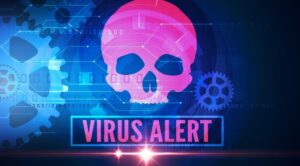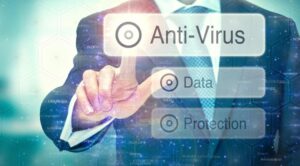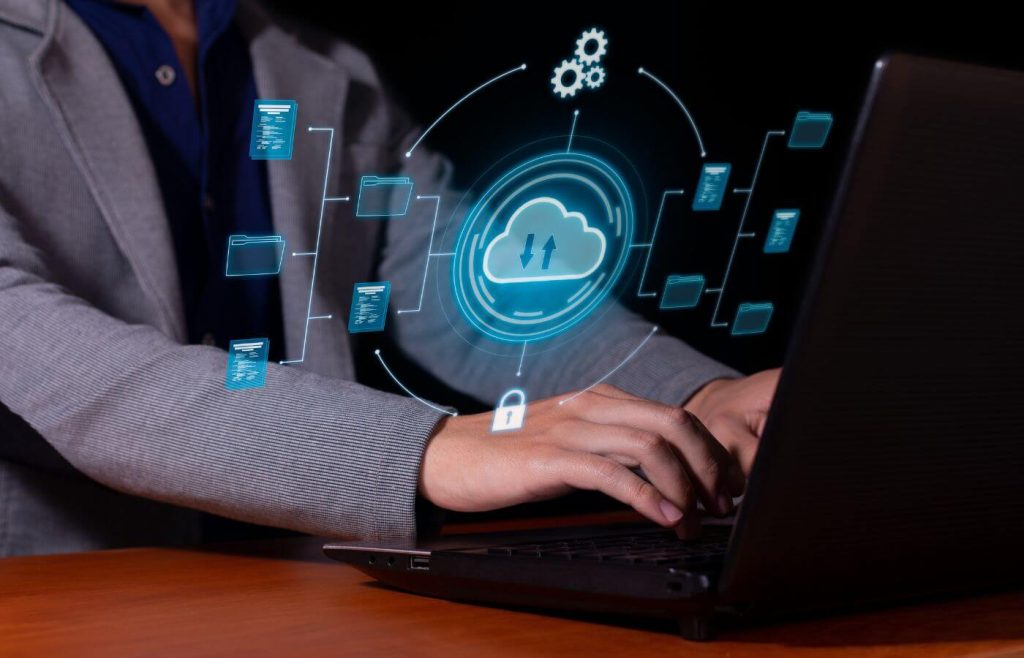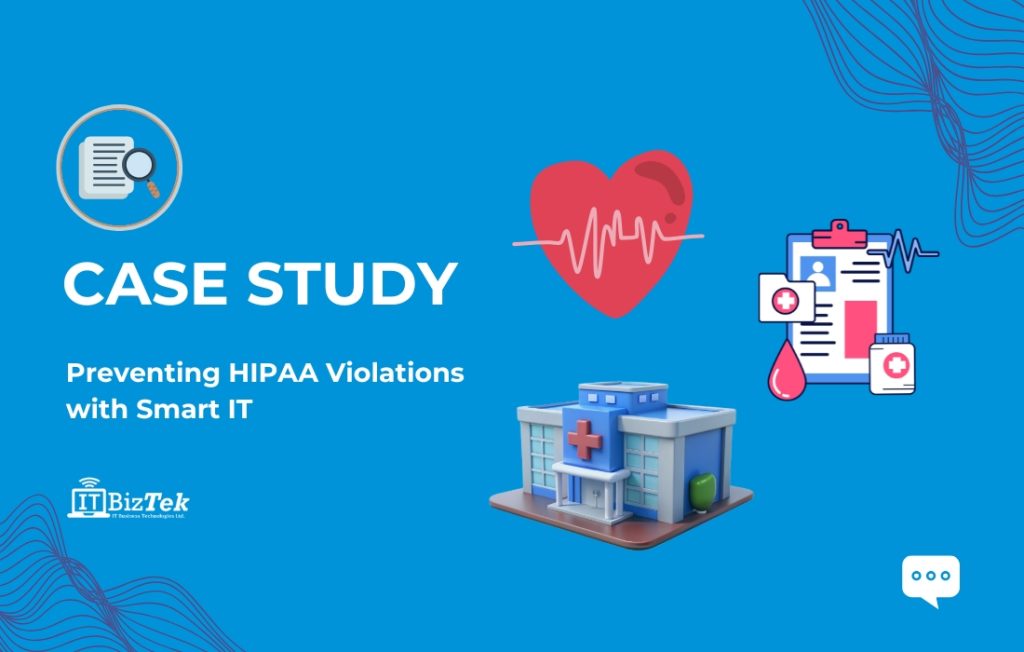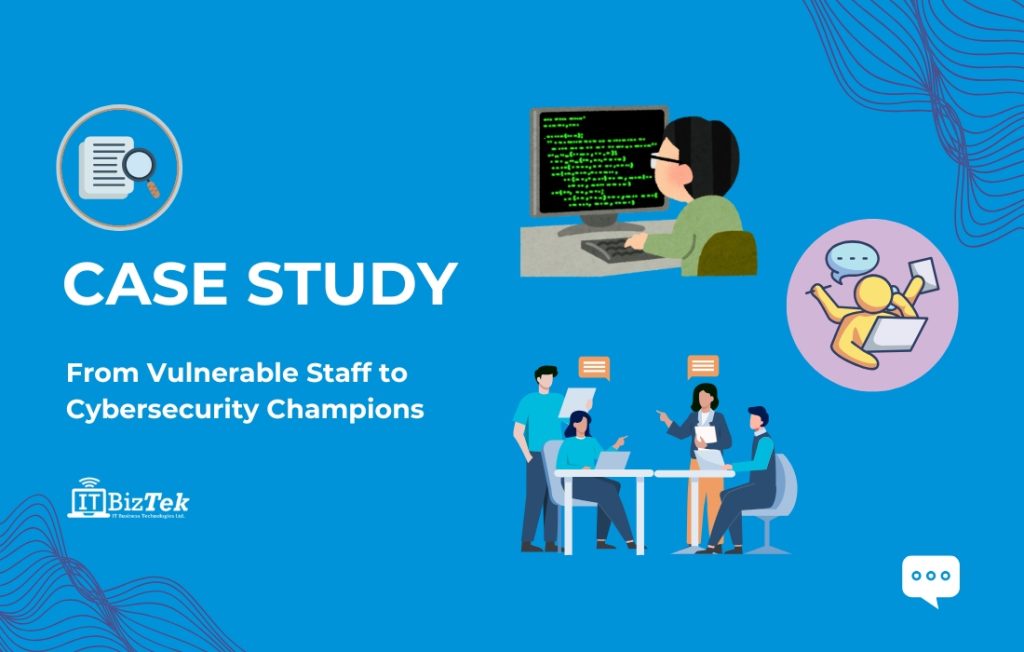The internet landscape is becoming an increasingly dangerous place for data breaches, viruses, and online threats. If you leave yourself or your business network unprotected, you could very easily become infected and become an unknowing victim to a wide array of detrimental crashes, bottlenecks and breaches. ITBizTek understands the modern e-commerce environment like the back of our hand, and we have all the right tools and services to ensure you are always protected. In this blog, we will give an overview of common online threats and issues, discuss in depth the purpose of each of them and offer your business options and solutions to keep your online digital security robust and bulletproof.
There are many types of online threats and viruses that businesses need to be aware of and new ones are being aggressively created and coded every day. Here are some of the most common online threats to businesses today:
Malware is a type of software that is designed to damage or disable computers. It can come in the form of viruses, Trojans, spyware, and adware.
Phishing is a type of online scam where criminals send fake emails or set up fake websites in an attempt to trick people into revealing personal information such as credit card numbers, passwords, or even bank account information.
A denial-of-service attack (DoS attack) is a type of cyberattack where criminals try to make a website or online service unavailable by overwhelming it with traffic from multiple computers.
SQL injection is a type of cyberattack where criminals insert malicious code into a website’s database in order to steal data or damage the site.
A botnet is a network of infected computers that are controlled by a hacker without the owners’ knowledge. Hackers use botnets to launch attacks, send spam, and spread malware.
Ransomware is a type of malware that encrypts files on a victim’s computer and demands a ransom be paid in order to decrypt them.
What is Malware and Why is it Dangerous?:
Malware is a type of software that is designed to damage or disable computers and computer systems. It can spread quickly and easily, causing major disruptions and even leading to complete system failure. Malware can be used to steal confidential information, destroy data, and disrupt operations. In some cases, malware can even be used to gain access to sensitive systems and networks.
Malware is a serious threat to businesses of all sizes. Even a small amount of malware can cause significant damage to a company’s operations and bottom line. Malware can lead to lost productivity, decreased revenue, higher costs, and reputational damage. In some cases, it can even result in legal liability.
There are many different types of malware, each with its own specific purpose and method of operation. Some common types of malware include viruses, worms, Trojan horses, spyware, and adware.
Viruses are a type of malware that can replicate themselves and spread to other computers. They typically require some user interaction in order to spread, such as opening an email attachment or clicking on a link. Once a virus has infected a computer, it can cause a variety of problems, including corrupting files, stealing information, and slowing down performance.
Worms are a type of malware that can spread itself without any user interaction. Unlike viruses, worms do not need to attach themselves to existing programs in order to spread. Instead, they create their own copies and send them out to other computers on the same network. Worms can cause a variety of problems, including overloading networks and causing Denial of Service (DoS) attacks.
Trojan horses are a type of malware that masquerades as benign programs or files. When executed, they can perform a variety of malicious actions, such as installing spyware or opening a backdoor into the system. Trojan horses are often spread through email attachments or links to websites that contain malicious code.
Spyware is a type of malware that is designed to collect information about a user without their knowledge or consent. Spyware can be used to track a user’s online activity, steal confidential information, and even gain control of the victim’s computer. In some cases, spyware can be difficult to remove and may require the help of a professional.
Adware is a type of malware that displays advertising on the victim’s computer. Adware can be bundled with legitimate programs or downloaded from malicious websites. In some cases, adware can be difficult to remove and may require the help of a professional.
Phishing:
Phishing is a type of online fraud that occurs when scammers pose as legitimate businesses or individuals in order to trick victims into providing sensitive information, such as credit card numbers or login credentials. This information can then be used to commit identity theft or financial fraud.
Phishing attacks are becoming increasingly sophisticated, and they can be very difficult to spot. That’s why it’s important for businesses to educate their employees about the dangers of phishing and how to protect themselves from these scams.
There are a few key things to look out for that can help you spot a phishing email:
- The sender’s address may not match the legitimate company’s domain name.
- The message may contain typos or grammatical errors.
- The email may contain a sense of urgency or threats in order to get you to act quickly.
- The message may direct you to click on a link that takes you to a fake website that looks very similar to the legitimate site.
If you receive an email that you think might be phishing, do not respond to it or click on any links. Instead, report it to your IT department or security team. By being aware of the dangers of phishing, you can help protect your business from these scams.
DDos or Denial-of-service attacks:
A Denial of Service (DoS) attack is an attempt to make a machine or network resource unavailable to its intended users. Although the means to carry out, motives for, and targets of a DoS attack may vary – they generally aim to prevent an internet site or service from functioning efficiently or at all, temporarily or indefinitely.
There are two general types of DoS attacks: those that crash services and those that flood services. The most common form of DoS attack is one in which the attacker seeks to overload the target system by flooding it with superfluous requests in an attempt to exhaust its resources so that it can no longer provide service. This type of attack is often referred to as a “bandwidth consumption” attack. Another type of DoS attack is one in which the attacker seeks to render a service unusable by crashing it, thereby preventing legitimate users from being able to access it. This type of attack is often referred to as a “resource starvation” attack.
DoS attacks are often launched by botnets, networks of infected computers that are under the control of an attacker. The attacker will use the botnet to send large amounts of traffic to the target system in an attempt to overload it. DoS attacks can also be launched by a single machine. However, such attacks are usually less effective than those launched by botnets because the attacker must generate all of the traffic themselves.
DoS attacks are a serious threat to businesses because they can render a company’s website or online service unavailable, causing lost revenue and customers. In some cases, DoS attacks can also lead to physical damage to the target system. For example, if an attacker overloads a server with requests, the server may overheat and catch fire.
There are several steps that businesses can take to protect themselves from DoS attacks. These include investing in countermeasures such as multiple servers and Internet connections, rate-limiting traffic, and blocking malicious traffic with a firewall.
ITBizTek knows the importance of a business having a plan in place for how to respond to a DoS attack. This plan should include steps for mitigating the effects of the attack and for recovering from it. ITBizTek has all of the IT tools and services to handle a DoS attack.
SQL Injection:
SQL injection is one of the most common and dangerous types of cyber attacks. It occurs when malicious code is injected into a website’s database, allowing attackers to gain access to sensitive information or even take control of the entire site.
SQL injection can have devastating consequences for businesses. In addition to the loss of sensitive data, businesses may also suffer reputational damage, financial losses, and legal liabilities. SQL injection attacks can be very difficult to detect and prevent, which makes them all the more dangerous.
Businesses need to be aware of the dangers of SQL injection and take steps to protect themselves. This includes ensuring that their websites are properly designed and secured and that their databases are regularly backed up.
By taking these precautions, businesses can help to protect themselves from the devastating consequences of SQL injection attacks.
Botnets:
Some people may have heard of botnets, but don’t really know what they are or how they can affect businesses. A botnet is a collection of internet-connected devices, which may include computers, smartphones, and other smart devices, that are infected with malware and controlled as a group without the owner’s knowledge. This allows cybercriminals to use the devices for a variety of nefarious purposes, such as launching denial of service (DoS) attacks, stealing data, or sending spam.
Botnets can be very dangerous to businesses because they can be used to launch large-scale attacks that can take down websites or disrupt services. They can also be used to steal sensitive data or infect systems with ransomware. In addition, botnets can be very difficult to detect and remove, which can leave businesses at risk of further attacks.
There are a few things businesses can do to protect themselves from botnets, such as keeping software and firmware up to date, using strong passwords and security measures, and being aware of the signs of an infection. However, the best defense against botnets is often a good offense – by proactively noticing, reporting, and in turn taking down botnets, businesses can help make the internet a safer place for everyone.
If you think your business may be at risk of a botnet attack, or if you suspect that your systems have already been infected, contact a reputable cybersecurity firm for help.
Ransomware:
Ransomware is a type of malware that encrypts a victim’s files and demands a ransom payment in order to decrypt them. This can be extremely dangerous for businesses, as it can result in the loss of important data or the interruption of critical business operations. Ransomware attacks can be difficult to prevent, so it is important for businesses to be aware of the risks and have a plan in place in case of an attack.
One of the biggest dangers of ransomware is that it can lead to the loss of important data. If files are encrypted, they may no longer be accessible and this can cause serious problems for businesses that rely on this data. In some cases, ransomware attackers will also delete backup files in order to make it even more difficult to recover lost data. This can leave businesses in a very difficult situation and can cause significant financial losses.
Another danger of ransomware is that it can disrupt critical business operations. If important files are encrypted, businesses may not be able to access them and this can lead to major disruptions. In some cases, ransomware attackers will also delete critical system files in order to make it even more difficult for businesses to recover from an attack. This can have a devastating impact on businesses and can result in significant financial losses.
Ransomware attacks can be difficult to prevent, so it is important for businesses to be aware of the risks and have a plan in place in case of an attack. There are a few steps that businesses can take to protect themselves, such as backing up important data and keeping security software up-to-date. However, even taking these precautions may not be enough to prevent an attack, and businesses should be prepared to deal with the consequences if one does occur.
Ransomware is a serious threat to businesses and can have devastating consequences. It is important for businesses to be aware of the risks and have a plan in place in case of an attack. Taking some simple precautions, such as backing up data and keeping security software up-to-date, can help reduce the chances of an attack occurring. However, even taking these steps may not be enough to prevent an attack, and businesses should be prepared to deal with the consequences if one does occur.
How Do I Protect My Business?
There are a few key things you can do to protect your business from online threats and viruses. First, make sure that your website is secure. This means having a good web hosting provider that takes security seriously and using SSL certificates to encrypt information sent between your website and visitors’ computers.
Second, be careful about the email addresses you use for your business. Hackers can often spoof email addresses, so it’s important to verify the sender of any email before clicking on any links or attachments. If you’re not sure about an email, don’t hesitate to contact the person or company directly to confirm its authenticity.
Third, keep your software up to date. This includes both the operating system on your computer and any applications you use. Outdated software often has security vulnerabilities that can be exploited by hackers, so it’s important to make sure everything is up to date.
Finally, consider using a VPN. A VPN (virtual private network) can encrypt all of the traffic between your computer and the VPN server, making it much more difficult for hackers to intercept or spoof.
ITBizTek has the expertise, tools, and infrastructure set up to protect you and your business network from all the above-listed threats. Our robust full suite of managed IT services can minimize your downtime in case of an attack, back up all your data with Cloud Backup services, and keep your business information and data as secure as possible. Get in touch with ITBizTek today so you can find out more about protecting yourself from these dangerous and costly online threats, breaches, hacks, and viruses.



